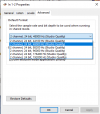This is a review of Motu M4 4x4 audio interface (DAC and ADC). It is on kind loan from a member and costs US $220.
The enclosure is heavy gauge metal and sturdy:
View attachment 81052
The front inputs are for microphones with higher gain. For my testing I used the Line in (and out) in the back:
View attachment 81053
For testing I installed the ASIO drivers which came with a nice little control panel that lets you set the sample rate and buffer depth. I had no difficulty operating the unit during my testing.
And oh, there is a headphone amplifier in there also which I tested as well.
DAC Audio Measurements
I started my testing with the M4 acting as a normal DAC using its balanced TRS jacks:
View attachment 81055
I don't know why but I expected the performance to be worse so was pleasantly surprised by the sum (ratio) of the noise and distortion in the form of SINAD. This places the M4 firmly in the top bracket of all DACs tested regardless of configuration:
View attachment 81056
View attachment 81057
Indeed it finishes just below Motu 624.
Dynamic range is very good, partly aided by more than nominal output voltage of 5.2 volts:
View attachment 81058
The default filter is not as sharp as it should be (typical) but has excellent attenuation:
View attachment 81059
Jitter is just shy of excellent:
View attachment 81060
Multitone test shows a typical rise in distortion with frequency:
View attachment 81061
Linearity (a measure of accuracy) was perfect:
View attachment 81062
Noise and distortion relative to frequency tells us what we already saw in multitone test:
View attachment 81063
Unfortunately the IMD test relative to level took us back a year or more to when DACs had a "hump" (increase) in distortion at mid-levels:
View attachment 81064
Motu would do well to read the threads here with a solution to this problem.
ADC Audio Measurements
Reversing the tables, my analyzer fed the M4 an ultra clean sine wave and asked it to digitize it:
View attachment 81065
This is with line in as indicated. With Mic in (not shown) and at minimum gain, SINAD drops just a few dBs to 100 or so. At higher gains it would go farther down to 94 dB or so. Back to Line In performance, this is good but some distance from state of the art:
View attachment 81066
The input is rated to 18 dBu which I used for most of the tests including this dynamic range:
View attachment 81067
Analog linearity was excellent:
View attachment 81068
Frequency response at full 192 kHz showed some odd peaking:
View attachment 81069
IMD vs level shows the same issue we saw with the DAC:
View attachment 81070
It shows to some extent in THD+N versus level as well:
View attachment 81071
THD+N versus frequency shows peaking at the extremes of frequency range:
View attachment 81072
Overall the ADC is less impressive than the DAC section.
Headphone Amplifier Audio Measurements
Let's see if this is a purely checklist item or useful by measuring its power versus distortion+noise into 300 ohm first:
View attachment 81073
The darn IMD hump shows up here yet again. That aside, available power is modest at just 18 milliwatts. Best to use an efficient headphone.
Let's see how it does with 33 ohm load:
View attachment 81074
So power level is more or less the same. The good news is that output impedance is quite low so should not change the tonality of the headphone.
Conclusions
Despite its budget price and wealth of functionality, the Motu M4 delivers on DAC performance with ratings that hold up well against some of our best budget DACs. Its ADC as noted is a step behind but still much better a lot of PC interface cards and consumer interfaces. The headphone amp is the weakest part but still it serves to be usable.
Overall, the Motu M4 makes for a good option even for people who just want a DAC. It gives you the additional input functionalities to say, produce a podcast or youtube video. Or test audio gear (to its limit of course).
Overall,
I am happy to recommend the Motu M4 Audio Interface.
-----------
As always, questions, comments, recommendations, etc. are welcome.
It seems no matter how much you all donate money, I still crave more! So I thought we try to find my limit by having you all donate a ton of new money. Maybe that will stop my begging. So go deep in your bank account and
donate heavily using
: https://www.audiosciencereview.com/forum/index.php?threads/how-to-support-audio-science-review.8150/


